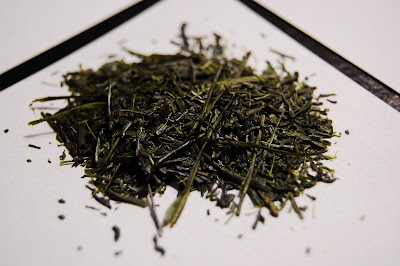
The dry leaf is neither light nor dark, neither very broken up nor whole. What the dry leaf does have is an abundance of stems. I tend to favor stemmy teas, I think the stems add complexity to the overall flavor. The smell from the leaf is pleasant, with a little bit of tart.

My usual parameters were used for the first infusion (2 tsp - 180 ml - 176°f - 1.5 min). The only tweaking of these parameters usually has to do with the infusion time. 45s for fukamushi, 1-1.5 min for chumushi, 1.5 for asamushi, 1 for karigane, guricha, and mecha. If the 1.5 minutes is too long, I'll adjust to a 1 minute infusion and see how that works. 2nd infusions need less time, and I generally just pour hot water in, and a few seconds later, pour the hot tea out.
The color comes out as a light yellow-green, full of small tea particles. The aroma is subdued, but sweet. The flavor is astringent. Light in the grass and vegetals, but there's an astringent sensation of the tea biting the tongue. It's quite surprising, and somehow enjoyable. I think this astringency is what makes the tea. Without it, it would taste ordinary. A few minutes later I get another shock from what this tea gives: a might caffeine kick in the rear. I start shifting in my chair while a light sweat breaks out.

Following infusions are smooth and creamy, while the liquor is still full of particles. Towards the bottom of the cup, where the particles lie, the astringency returns.
Now, just what brewing parameters should be used? I have no fracking clue. You can check this thread to see where the conversation has gone. I believe that the astringency is the product of an odd processing method where the leaf was slightly oxidized. Might it have been a mistake? It's possible. I see two possible brewing techniques: do it normally and get used to the astringency, or brew at cool enough of a temperature (~140°f) to keep the bitter bits from being released en masse. One could also try filtering out the particles which might be responsible for the astringency. I will continue to tweak parameters, and leave a comment on this post if I do find Surugawase's "sweet spot."
0 comments:
Post a Comment